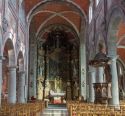Church | 1926 | Modern | Catholic Church


Map
Opening hours
01 January - 31 December
Mon 9.00 - 17.00
Tue 9.00 - 17.00
Wed 9.00 - 17.00
Thu 9.00 - 17.00
Fri 9.00 - 17.00
Sat 9.00 - 17.00
Sun 9.00 - 17.00
Guided tour
Religious offices
Saturday 6 pm (Every other Saturday)
See the updated timetable on the website of our partner Egliseinfo
Or on the parish website
Description
After the fire in 1918 in the old 18th century building the architect, Henry Lacoste, built this new church influenced by Art Deco, which one rarely sees in religious buildings. The triangular façade and the high octagonal clock tower detached from the building reminds one of a minaret.
Inside, a large nave, a bare choir, brightness and astonishing stained glass windows which mirror the modern style. Large ferro-concrete arches without pillars. It is said that the curé at the time did not want pillars so that his farmer parishioners could not hide to talk of cows, sheep or pigeons.
Photos
Media
Remarkable elements
Choir stained glass window
Covering almost entirely the chevet of the choir, this stained glass window is similar to the walls of light. It represents in 6 vertical rectangles arranged in steps identical angels, symmetrically placed. Their hieratic position resembles Byzantine stiffness. These angels each present a host and surround the altar at the time of consecration. Their wings are oriented one upwards and the other downwards, emphasizing the role of the angel as mediator between heaven and earth, between God and men.
Paul Leclercq's workshop, Ixelles.
Translated with www.DeepL.com/Translator
The tomb of Saint Aybertus
Tank of the authentic sarcophagus of Saint Aybert (1060-1140). Originally from Espain, a primitive village in Bléharies, Aybert led a hermit's life attached to the Benedictine abbey of Crespin (F). He was buried near his hermitage and his tomb was forgotten, and it is known that at the end of the 19th century, the tank was used as a drinking trough for the cows. Found by the priest E. Druez, it was brought back in 1932 and installed behind the main altar on Lacoste's plans.
The recumbent is the work of sculptor F. Debonnaires (1932).
Translated with www.DeepL.com/Translator
Pulpit
Original work of art based on a sphere and whose octagonal bowl originates from an inverted pyramid. The canopy is decorated on the inside with a mosaic representing the Lamb of God, which replaces the traditional dove. The Lamb also underlines Lacoste's will to make the whole church the home of the Good Shepherd.
Statue of Saint Aybert (right altar)
Work by Fernand Debonnaires (1907-1997). The sculptor perfectly rendered the simple monastic figure of Aybert in stone, through his simple style. Saint Aybert became the patron saint of the parish, as soon as the church was inaugurated, thus supplanting Saint Amand (see statue at the back of the church).
Suspended lights
They are numerous and all identical. They hang down with a wire from the arches, all to the same height, and attach themselves to a metal ball, pierced by small crosses.
All these verticals create a harmonious contrast with the arches and represent a repetitive rhythm, in which the oriental influence clearly seeps through.
Reinforced concrete - plastering - colours
By using reinforced concrete in a religious construction, Lacoste is a pioneer in Belgium. The large arches, pierced by a triplet of bays, make it possible to open up the space considerably and let in plenty of light.
Concrete is at the base of any interior construction: it is dressed with "lap" to simulate panelling (preventing any intrusion of nails...) and granitos decorated with motifs (lamb) or cords, in mosaic, on all elements of fixed furniture (ambons, altars, communion benches, pulpit, baptistery...) The colours are reduced to elementary ones by playing on complementary ones. The result is a great uniformity and serenity conducive to prayer.
























